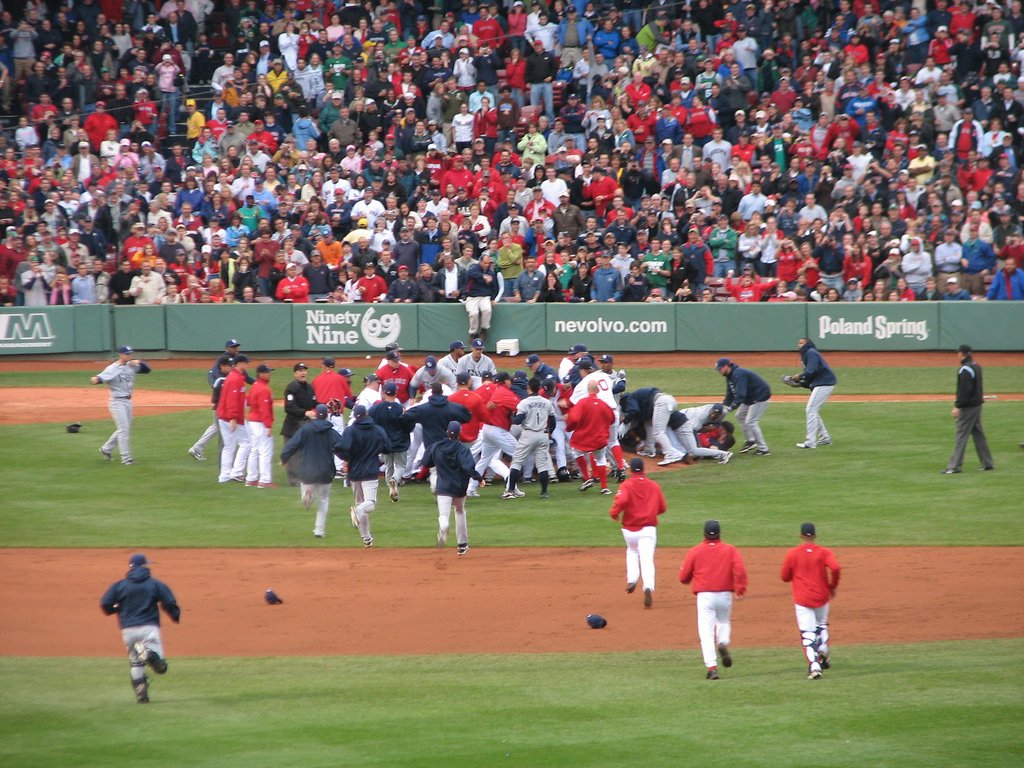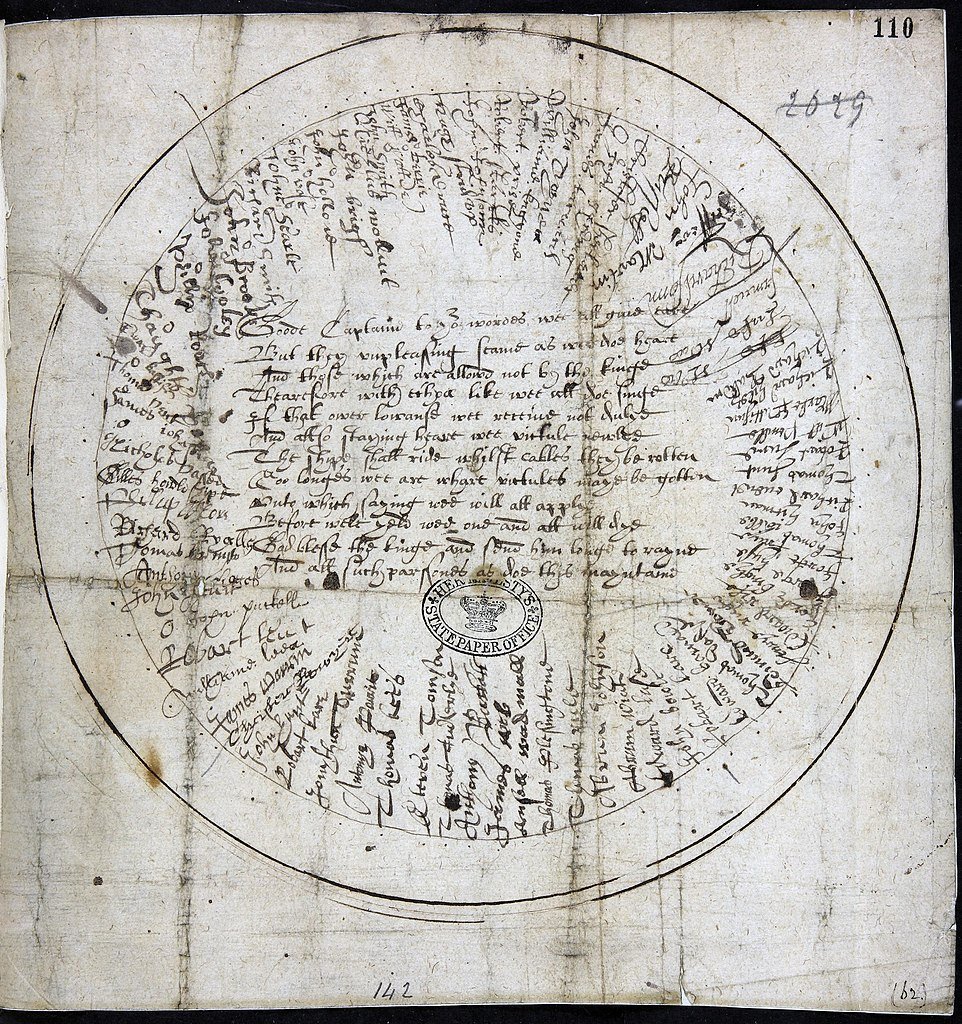7 June 2023
Rhubarb is any one of a variety of edible stalks of the genus Rheum. It has a strong tart taste, and as a result, while rhubarb is biologically a vegetable it is often considered more like a fruit in culinary circles, where it is often used in pies and pastries. Rhubarb also used to (still?) be used as a purgative. But in slang use, rhubarb has come to mean nonsense or rubbish, and in baseball circles, a rhubarb is a dispute, argument, or fight.
The English name for the plant comes from the Anglo-Norman reubarbe (1212), which in turn is from the post-classical Latin reubarbarum, and that from the Hellenistic Greek ῥῆον βάρβαρον (rion barbaron, barbarous rheum). It was “barbarous” because it was not cultivated in ancient Greece, but rather in the Black Sea region. The English word is in place by c.1390, when it appears in the poem “The Pistel of Swete Susan”:
Columbyne and charuwé clottes þei creve,
With ruwe and rubarbe, ragget ariht.(Columbine and caraway flourishing in clumps,
With rue and rhubarb ragged in the right way.)
How rhubarb came to mean nonsense is uncertain, but it happened by the beginning of the nineteenth century. The sense may come from a certain theatrical practice, where actors would repeatedly utter the word rhubarb to simulate the noise of a crowd, but this practice is not attested to until considerably after the nonsense sense. Still, it may be the practice is older and just not remarked upon in print.
The earliest example of the word being used to mean nonsense that I have found is in George Colman’s 1801 play The Poor Gentleman. In Act 2, Scene 1, two soldiers, Foss, a corporal, and Ollapod, an officer, are conversing:
Foss. Why your honour, I have seen a good deal of service in the regular way; and know nothing about Associations; but I think, an’ please your honour, if men take up arms to defend their country, they deserve to be thank’d, and respected for it, and it doesn’t signify a brass farthing what they are called.
Olla. Right—the name’s nothing—merit’s all—Rhubarb’s rhubarb, call it what you will.
Earlier in the play, Ollapod remarks upon an officer ostentatiously wearing a uniform rhubarb-colored lapels. Whether his saying rhubarb’s rhubarb, call it what you will is a reference to that earlier scene or to an already existing sense of the word meaning nonsense is uncertain.
Colman’s play was quite successful, and two decades later, the line rhubarb’s rhubarb, call it what you will was quoted in the 22 September 1823 issue of The Mirror of the Stage, so it is not inconceivable that Colman was the originator of the slang sense. At the least, his play probably had a role in popularizing the sense.
We see the nonsense sense again in William Johnson Neale’s 1841 novel Paul Periwinkle:
In vain Bamboozle endeavoured to coax up a reply from the bottom of his throat, the words were frozen there. He got as far as “I—I—I,” and then the heavy fist of Alibi finished the rest of the sentence by the most forcible of all arguments, which the learned have termed the argumentum bacculinum, and the unlearned “the knock-down.”
“I hope that's finished you! You thrice-dyed incarnation of lies and rhubarb!” proceeded Alibi, speaking in his wrath as loudly as if the words could still annoy the bleeding ear of poor old Bam, who lay as flat upon the deck as if he never should rise more.
So, rhubarb meaning nonsense was well established by the mid nineteenth century, but the theatrical practice uttering the word rhubarb to simulate the murmuring of a crowd isn’t recorded until the twentieth century, although it may in fact be much older. The earliest mention of the practice that I’m aware of is in an article about the actor Elliott Dexter in the February 1919 issue of Motion Picture Magazine:
To return from the piscatorial to biographical, [Elliott] Dexter began his stage career as a supe, which is a noisy dram for extra, in “The Great Diamond Robbery,” at the American Theater, in New York. He didn’t carry a spear in this dramatic masterpiece, probably because there were no spears to carry, but he did grumble, “Rhubarb, rhubarb, rhubarb” off stage to make up the angry mob.
In baseball circles, however, a rhubarb is a dispute or a fight. It is claimed that this sense is a coinage of sportswriter Garry Schumacher, but no one has found an early use of the term by him. This baseball sense of rhubarb was popularized by famed sportscaster Walter Lanier “Red” Barber, who used the term frequently. It is likely that Barber began using rhubarb in the late 1930s when he was covering the Cincinnati Reds, but the baseball sense of the term is not recorded until 12 April 1940, when it appears in the pages of the Brooklyn Daily Eagle. By this time Barber was calling the games for the Brooklyn Dodgers, and it was he who undoubtedly brought the term to Brooklyn. The article in the Daily Eagle is about the possibility of Chicago Cubs pitcher Dizzy Dean joining the Dodgers, something that did not happen. Here rhubarb is used to mean trouble:
Well, in those not forgotten days, Leo [Durocher] was Dizzy’s friend, counsellor and guide. Probably Durocher’s sage advice kept the ex-cotton picker out of many a mess of rhubarb.
And we see the dispute sense in the pages of the New York Times on 19 May 1941, again in a reference to Brooklyn, who had played the Cubs the previous day:
There was what the boys call “a bit of a rhubarb” in the eighth when Cavarretta tried to steal home as Tamulis tossed the ball to first. In the ensuing run-down, the Cubs charged Phil’s progress was illegally blocked by Lavagetto. Umpire Al Barlick ruled otherwise.
And to round out the early appearances of the baseball sense, there is this from the New York Herald Tribune of 25 September 1942 about Larry MacPhail, manager of the Dodgers:
Unless Larry turns up some kind of rumpus today he apparently is going to stand on his last two “rhubarbs,” i.e., the recent ruckus with Bill Klem, the old arbitrator, and the telegraphic altercation recently undertaken with Bill McKechnie, the Cincinnati manager.
So, how the plant became associated with nonsense is unknown, but that slang sense probably gave rise to the theatrical practice of repeating saying rhubarb to simulate crowd noise. The idea of an angry crowd may, in turn, have given rise to the baseball sense of a dispute or fight. But the connections between all these senses are a bit tenuous.
Sources:
Anglo-Norman Dictionary, 2021, s.v. reubarbe, n.
Colman, George. The Poor Gentleman (performed 11 February 1801). London: A. Strahan, 1802, 2.1, 24. HathiTrust Digital Archive.
The Dickson Baseball Dictionary, third edition. New York: W.W. Norton, 2009, 704–06, s.v. rhubarb, n.
Dictionary of Medieval Latin from British Sources, 2013, s.v. reubarbarum, n. Brepols: Database of Latin Dictionaries.
Green’s Dictionary of Slang, 2023, s.v. rhubarb, n.1. https://greensdictofslang.com/entry/yk4ob2q
Holmes, Tommy. “Dizzy Dean is Dodger Possibility” (12 April 1940). Brooklyn Daily Eagle, 13 April 1940, 5/4. Brooklyn Public Library: Brooklyn Newsstand.
McGaffey, Kenneth. “The Excellent Elliott.” Motion Picture Magazine, February 1919, 37. Media History Digital Library.
McGowen, Roscoe. “Wyatt Loses 7–4, After 7 Straight.” New York Times, 19 May 1941, 20/6. ProQuest Historical Newspapers.
Middle English Dictionary, 2019, s.v. rubarbe, n.
Neale, William Johnson. Paul Periwinkle: or, The Pressgang. London: Willoughby, 1841, 615. HathiTrust Digital Archive.
Oxford English Dictionary, third edition, June 2010, s.v. rhubarb, n. and adj., rhubarb, v.
“The Pistel of Swete Susan.” In Russell A. Peck, ed. Heroic Women from the Old Testament in Middle English Verse. TEAMS Middle English Text Series. Kalamazoo, Michigan: Medieval Institute Publications, 1991, lines 111–12. Oxford, Bodleian Library MS. Eng. poet. a. 1 (The Vernon Manuscript).
Popik, Barry. “Rhubarb (A Heated Dispute),” Barrypopik.com, 17 July 2015.
“Theatrical Diary.” The Mirror of the Stage, 3.4, 22 September 1823. London: Duncombe, 1824, 60. HathiTrust Digital Archive.
Tréguer, Pascal. “Sense Evolution of ‘Rhubarb’: From Theatre to Nonsense.” Wordhistories.net, 28 January 2022.
Woodward, Stanley. “Views of Sport.” New York Herald Tribune, 25 September 1942, 27/2. ProQuest Historical Newspapers.
Photo credit: Kevin Bedell, 2008. Wikimedia Commons. Licensed under a Creative Commons Attribution-Share Alike 2.0 Generic license.




